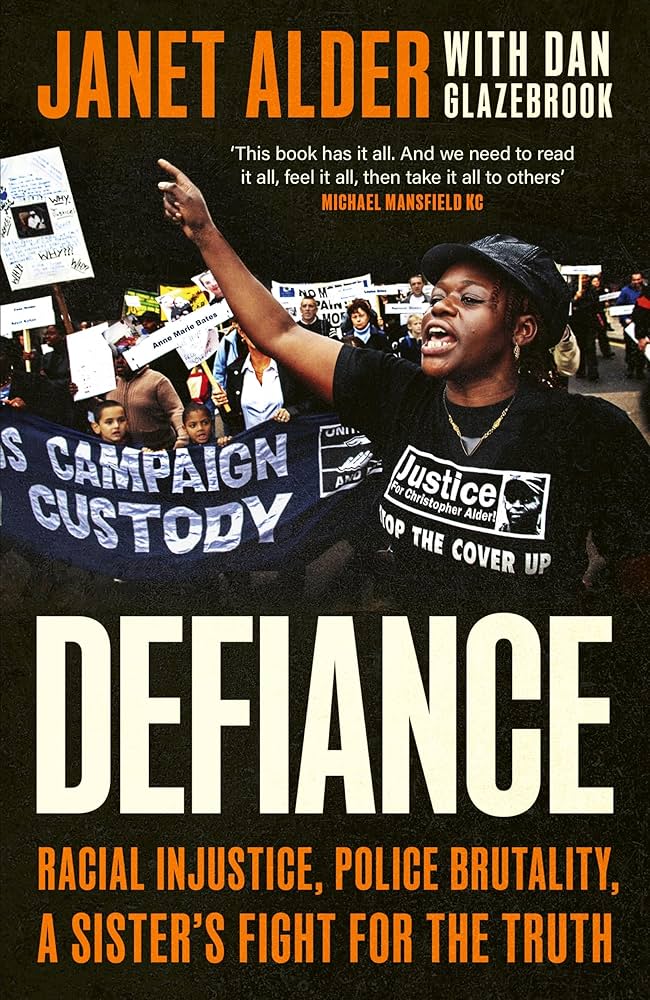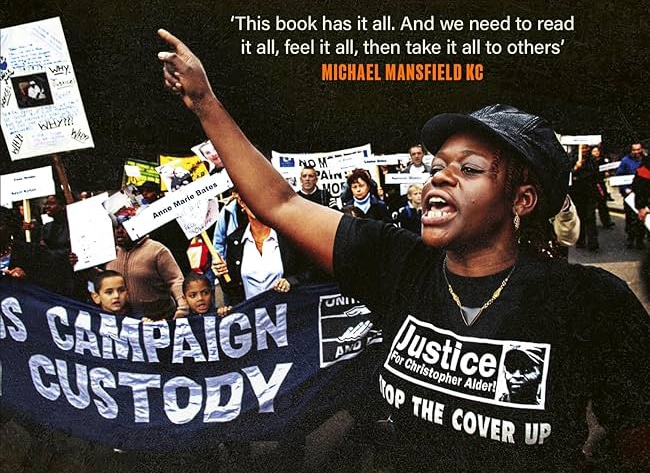Defiance: racial injustice, police brutality, a sister’s fight for the truth, Janet Alder with Dan Glazebrook, Dialogue Books, 2024, 447pp, hardback £25

Christopher Alder, a 37-year-old black man, was killed by Humberside Police in Hull on 1 April 1998. The autobiography Defiance by his sister, Janet Alder, is an account of her fight for justice. It shatters all illusions that police brutality and state racism are a problem of ‘a few bad apples’ or that the working class, particularly black people, can expect any justice from the British state.
The book opens with a harrowing description of Christopher’s final moments which were caught on CCTV. He was dragged, unconscious and handcuffed, into Queen’s Gardens Police Station and left on the floor of the custody suite. He was bleeding from a head wound, missing two teeth, bleeding from his mouth, vomiting and suffocating. While Christopher lay dying on the floor, five officers stood around him, laughing and joking with one another while deciding what to charge him with. Twelve minutes later, the officers realised he had stopped breathing but their attempts to resuscitate him were too late.
The night he died, Christopher was punched in the face by Jason Paul during a fight outside a nightclub. He lost a tooth and hit his head on the pavement. He was taken to hospital where he is alleged to have acted ‘erratically’. After having his injuries examined, he was escorted from hospital by two officers who then arrested him to ‘prevent breach of the peace’. In the period between his arrest and arriving into custody, Christopher had lost another tooth, was bleeding from a head wound and unconscious.
The cover up
Janet Alder was informed of her brother’s death on 17 April, only being told that he had died in police custody. No other details were given. When Janet travelled to Hull to press the police for answers she was intimidated and dismissed.
The police were already in the process of covering their own backs. Janet learned from the local press that Jason Paul had been arrested and charged in connection with Christopher’s death. The police had also misinformed the press that Christopher was arrested for ‘assaulting a hospital worker’. The attempt to frame Jason Paul and smear Christopher’s character soon unravelled as more facts came to light.
Throughout the book more details of the police’s attempts to cover their tracks are revealed. It was suspected (and likely) that Christopher was beaten and sprayed with CS gas in the police van. This would explain why he couldn’t breathe and why he had fresh injuries when he arrived to the police station. The police destroyed his clothes so that testing for CS gas was impossible and an inquiry held in 2000, which returned a verdict of unlawful killing, revealed that the police had cleaned Christopher’s blood from the police van before any forensic analysis could be done.
No justice in racist Britain
Janet’s campaign can be split into two parts. Firstly the street work, which involved demonstrations outside Queen’s Garden Police Station, speaking at meetings, publicity and so on. The second part was the endless legal process, which involved establishing Christopher’s cause of death, the inquiry, battling with the CPS, the trial of the officers and civil cases.
The racism of the British legal system was quickly evident. The CPS did everything in its power to protect the officers responsible for Christopher’s death. When Janet raised the obvious fact that racism had been a contributing factor in Christopher’s treatment, the CPS dismissed this out of hand and claimed that there was no evidence. This was proven to be a lie when, on the CCTV footage, the officers could be heard making jokes about ‘banana boats’ and monkey noises while Christopher was dying on the floor of the custody suite. The officers also referred to him as ‘coloured’ and a ‘negroid’ in their statements.
Despite the CPS dragging its heels, the five officers were eventually charged with manslaughter in 2002, two years after the inquiry returned a verdict of unlawful killing. When the trial started in April that year, the prosecuting barrister deliberately sabotaged his own case. He described Christopher as ‘aggressive’ and whitewashed the actions of the police. Before the defence could even present their arguments the judge had to dismiss the case. The police had won.
An enemy of the state
Janet and her family were targeted by the state. Demonstrations organised by her campaign were subject to close surveillance. Her phone was wire tapped and the police extensively looked through her family history for material to discredit the campaign. A 2015 IPCC report revealed that surveillance on Janet, her family and her solicitors was authorised in all areas covered by the Humberside Police from summer 2000. Despite the operation being ‘not properly authorised’ and having ‘racist motives’ no officers were disciplined.
The state also attempted to terrorise Janet and her family into silence. Her brother Richard was vindictively arrested, prosecuted and convicted. Janet herself was dragged in front of the courts after defending herself from a racist attack.
The state’s attacks on the Alder family reached disgusting levels when, in 2011, it was revealed that Christopher’s body had not been released to the family for his funeral in 2000. His body had been swapped with 77-year-old Grace Kamara.
Political lessons
Janet’s political development can be traced throughout the campaign for her brother. She was not political until Christopher’s murder forced her to be. She soon recognised that she could not trust the police nor rely on the state for any sort of justice. As she herself writes ‘Those charged with upholding accountability have instead upheld impunity, whether under Labour or Conservative governments’ (p421).
She draws valuable political conclusions when reflecting on 2020 Black Lives Matter uprisings. As Janet correctly notes ‘Only after the Minneapolis police precinct was burned to the ground was Floyd’s killer charged with second degree murder’ (p424). She therefore concludes ‘it is only pressure from the people that forces institutions to move’ (p424-425).
The state presents itself as a neutral body, standing above society and dispassionately dispensing justice. The case of Christopher Alder destroys that myth entirely. In capitalist society, such a state cannot exist because the state is a tool to oppress the working class. Janet points out that the successful prosecution of Police Constable Benjamin Monk for the killing of Dalian Atkinson in 2021 only happened because the CPS feared a repeat of 2020.
While the book is an autobiography, and therefore not a deeper analysis of British state racism in general, it remains a must-read for anyone who wants to understand the nature of racist policing, the ‘justice’ system and what it takes to fight back. Black people continue to struggle against state racism and this book provides invaluable lessons for the political battles ahead.
Kotsai Sigauke
FIGHT RACISM! FIGHT IMPERIALISM! 304 February/March 2025




